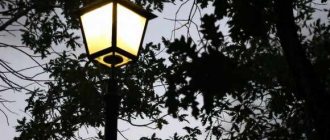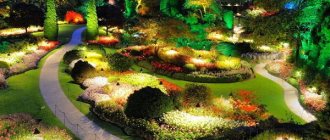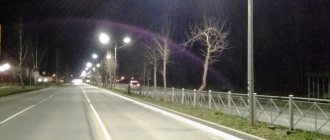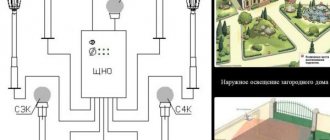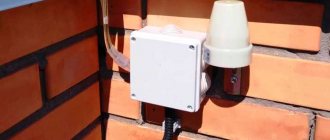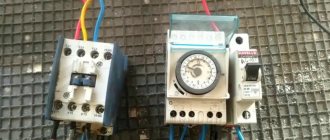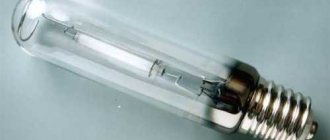Sufficient visibility at night has long become the norm not only in the city, but also for countryside farming. Thanks to the introduction of modern technologies and a wide range of lighting and electrical equipment, outdoor lighting acquires the most incredible features, both in terms of functionality and decorative qualities.
Due to the rather high cost of designing and further installing the system, many owners are interested in how to make street lighting with their own hands.
Basic points
Before undertaking the design of lighting structures, it is necessary to take into account the basic requirements associated with the location. Thus, due to heavy rainfall and temperature fluctuations, which adversely affect the technical condition of lighting devices, and a number of associated factors, it is necessary to adhere to the basic principles in choosing street lamps:
- Resistance to moisture and dust - Unlike indoors, outdoor lighting is bound to encounter dust in dry climates and moisture in a variety of forms, from aerosol to streams and even partial immersion. This parameter is indicated by the IP marking and two numbers; the most airtight models of street lamps with a degree of IP68 are considered.
- Mechanical resistance to gusts of wind - a street lighting device must have a durable body and high-quality fastening so that they are not torn off by the first small hurricane.
- The luminous flux from a lighting fixture must provide sufficient visibility, so it is important that the right type of luminaire is selected for each type of lighting.
Types of outdoor lighting
Through the use of lamps and luminaires of various powers and designs, street lighting allows you to solve a variety of problems. All outdoor lighting can be divided into:
- functional – provides a sufficient level of visibility in summer cottages;
Functional street lighting
- facade - at the same time used both to designate a building and to improve visibility in the nearby area, flower beds, paths along with the facade of buildings;
Facade lighting
- marking – used to highlight the contour of any interior element: garden paths, fencing, perimeter, etc.;
Marking lighting
- decorative - intended for decorating personal plots and individual details: illumination of fountains, trees.
Decorative lighting
Types of lamps used
The design of street lighting devices can be installed either separately or on existing parts. Here we should highlight wall lanterns, pendant models, garden lamps with legs, mounted on a bracket or on a pole, spotlights, floor garden lanterns and other options.
Variety of lamps
In terms of construction and design, the choice is generally unlimited, and if desired, you can decorate any element of street lighting at your own discretion.
Cable laying methods
In practice, the most popular cable placement methods are:
- underground - allows you to hide all communications and power supply lines, the cable in this option is more protected from atmospheric influences, but the amount of work and costs for it are quite large;
- by air - in this case the entire line will remain visible and will become another design element that does not always fit well into the overall picture;
- along the facade of a building or other structural elements of a building - the simplest method, since there is no need to install supports or dig a trench, but the scope of application is limited by the location of buildings and the area of \u200b\u200bthe lamps.
Power supplies
The following can be used as a power source:
- electrical network 220 V;
- reduced voltage 12, 24, 42 V, etc.;
- autonomous power sources (batteries and solar panels).
The first option is the simplest from the point of view of implementation; you just need to stretch a line from the distribution panel to the desired location. The second method is the safest, since even if the insulation is damaged, electric shock will not harm a person. The third method is the most economical, since in combination with LED lamps, solar panels will provide free lighting.
Types of supports
Support structures for illuminating a suburban area are used not only when the line is laid open, they hold lanterns and spotlights. Structurally, these can be pillars, brackets, cables, pins, etc.
In some cases, decorative landscape elements - parapets, trees, fencing - can be used as supports. The support parameters and their number are selected depending on the weight of the lamp, cable and sag in relation to the ground. Depending on the material, the support can be made of wood, metal or plastic.
Example of lamp supports
Manual or automatic lighting control
There are two ways to turn it on - manually and using automatic systems. Manual control can be done using switches, switches or even a remote control. Automatic involves the use of photo relays or motion sensors. Both options are suitable for both main lighting and decorative lighting.
Work planning
Work on lighting the area of a private house should begin with the creation of a plan. You should work out an idea of how everything will subsequently look. Will the paths and gazebo in the garden be illuminated or just the main building? Do you need lighting for flower beds, decorative trees or a decorative wall? What kind of lamps will there be: flashlights, spotlights, or maybe diode strips? And are there any other works planned on the territory?
The finished idea needs to be transferred to paper, drawing up a plan for the location of objects. The plan does not have to be scrupulously verified; a clear understanding of what and where should be in the end is sufficient. It is also worth deciding on the placement of other electrical appliances: motion and light sensors, electrical wiring lines, switches and sockets.
The plan can be drawn up in any convenient way:
- Use a printer to make several copies of the site passport. And place objects on the received copies, draw various arrangement options.
- If you don’t have a site passport, you can create a rough plan on drawing paper. Draw a so-called situational diagram. Dividing the sheets into cells will help to correctly scale the area. In this case, it is better to focus on a scale of 1:100, where there will be 1 meter of land per 1 cm of paper.
- Create a plan in a computer program, such as a landscaping application or lighting design program.
To save money, it is recommended to place street lights in such a way that their illumination radii do not intersect with each other. It is better if they are located at some distance from each other.
Electrical installation work step by step
Once you have decided on the type of lamps, the source of electricity, and the method of placement, you can proceed to electrical installation work. At this point, all the wiring in the house has already been installed, the metering devices have been installed, and all you have to do is light the garden area. To do this, you need to perform the following sequence of actions.
Preparation
At the preparation stage, it is important to take into account the installation locations of supports and cable routing in relation to the landscape design. Along the proposed cable route, the space is cleared of debris and foreign objects. Prepare the necessary tools and materials - for excavation work, a shovel, a hammer, a jackhammer, buckets or other container for removing excess soil.
For outdoor installation of decorative and functional lighting, you will need a ladder or other support to reach a height. Tools for laying cables through the air, support elements, insulators or other fasteners.
Calculations
At the calculation stage, you should have a clear idea of the number of lamps and their total power. This will be needed to determine the cross-section of the cores; it should be noted that each section of street lighting has its own cable wiring, for example, it can be divided into the following types:
- track lighting;
Track lighting
- lighting of a fountain, pool or other bodies of water;
Fountain lighting
- functional lighting of both the general area and individual locations;
- architectural lighting of the building facade;
- decorative lighting for fences;
- LED lighting of individual decoration elements (trees, garden figurines, etc.).
Tree lighting
You can choose not the entire list, but only the ones you need. Next, the cross-section is calculated, for example, to illuminate the paths you will need 15 lamps, the power of each will be 10 W, respectively, the line for LED spotlights should normally withstand 150 W. To illuminate the local area, 4 wall lamps of 200 W are used, respectively, the line is calculated at 800 W.
After this, select the most suitable option, it is better to ensure a power section reserve, the ratio is selected from the table:
Table: wire cross-section, depending on the load size
For example, for a power of 150 W (0.15 kW), a cross-section of 1.5 mm2 for copper is more than enough; the same cross-section is sufficient for a power of 800 W (0.8) or 2.5 mm2 for aluminum. On sale you can find brands of cable and wire products with a smaller cross-section, but for street lighting this is impractical due to poorer mechanical strength.
Creating a Project Diagram
Lighting diagram
To design a street lighting connection diagram, it is quite convenient to use a site plan indicating all buildings, the location of pedestrian paths, and decorative elements in the design of the dacha. When designing, you should be guided by the following principles:
- If the line is laid underground, the depth should be planned at least 0.7 - 0.8 m. At the same time, at least 0.6 m should be set back from the foundations of buildings, and at least 0.5 m from pipelines and other communications.
- For an overhead line of street lighting, the sag should be arranged so that from the bottom point of the wire to the roadway there is at least 6 m, and in the pedestrian area at least 3 m.
- The location of facade lighting and street lamps must be chosen in such a way that the flow does not enter the windows, as it will interfere with sleep, and does not illuminate the neighbor’s yard or other space you do not need.
- Lighting devices are installed in such a way that the illuminated spaces intersect as little as possible, this will save on the installation of lamps.
Installation of supports
The supports can be used both for hanging street lighting wires and for placing lamps on them. Installation of supports is carried out on a pre-prepared foundation. For the foundation, a hole is made with dimensions larger than the support area, and formwork made of flat boards, plywood or similar parts is installed in it. Concrete is poured into the formwork; to increase strength, you can add crushed stone, granulated slag or other reinforcing components to it.
Embedded reinforcement and foundation for support
In the still wet solution, embedded reinforcement is placed, onto which the support can then be attached. A hollow space is created in the center of the foundation for installation of wiring when laying underground cables.
Installation of supports on the foundation is carried out level; the permissible tilt should not exceed 3°. Otherwise, you will get significantly less efficient street lighting.
Connection
After completing the installation work, when you have installed the supports, hung the lamps and laid the power supply lines for street lighting, you can connect all the elements of the circuit.
When making electrical connections, it is important to comply with the following requirements:
- all points are fastened with clamps, bolted connections or soldering; twisting should never be used;
- It is advisable to check each finished circuit with a multimeter for integrity (no breaks or short circuits). Additionally, you can check the value of resistance and, as a result, power consumption;
- first connect the entire circuit, check it, and only then connect the line to the circuit breaker on the distribution panel.
After completing the connection, be sure to check that all street lighting is working. If some lights do not light up, first turn off the entire line, and only then disassemble and check the condition of the contacts and connections.
Advice from an expert
A few tips from a professional electrician will help you significantly improve your street lighting system and avoid basic mistakes:
- when designing and installing lamps, it is necessary to ensure free access so that burnt out lamps can be easily replaced;
- Of the existing variety of lighting devices, it is better to give preference to LED lamps, they are much more economical and more profitable to operate;
- It is advisable to use cables and wires with copper conductors as wiring; they can withstand mechanical loads and temperature changes much better;
- For underwater lighting, special sealed devices are used; ordinary lamps will instantly fail;
- for safety purposes, street lighting must be equipped with protective grounding and an RCD;
- the selected lighting devices must correspond to the task assigned to them - low-power lamps are sufficient for decorative functions, and a spotlight at the front door, on the contrary, should provide maximum visibility.
Sensors
Motion sensors allow you to significantly save on electricity, since they turn on the light only when motion is detected within the range. Such a device not only protects the home, but also creates comfort, since the owners do not have to look for the switch in the dark. Motion sensors are also used for decorative lighting, when spot lighting appears directly in front of the feet and disappears immediately behind the person.
Light sensors (automatic photo relay) react to a decrease in the overall level of illumination on the street and, when dusk sets in, they themselves give a command to turn on the lamps. Human participation in this process is not required.
Garden sensors also have good protection against moisture and dust, which allows them to be used safely in any weather.
